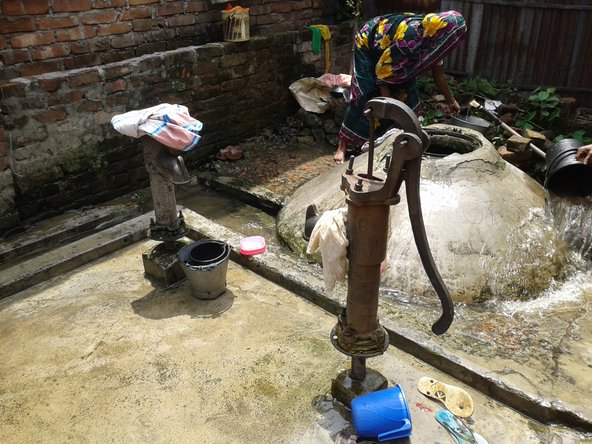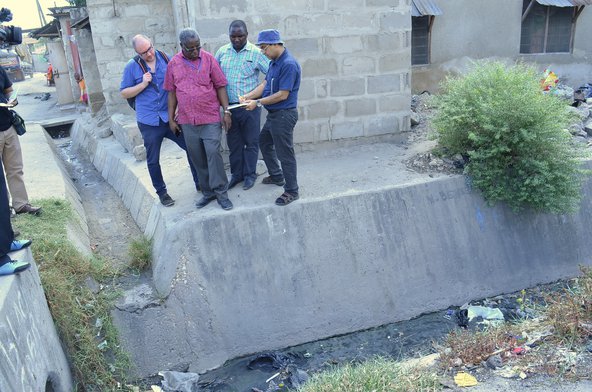'The Last 100 Metres': Safeguarding Potable Water Provisioning to Urban Informal Settlements
- Project status
- Ongoing
- Programmes
- Sustainable Development 2016 Programme
- Departments
- International
The last two decades have seen much improvement to drinking water supplies to millions of poor urban people across the developing world. However, potential benefits of improved water supply are severely compromised by faecal contamination at a critical zone around the point of use – regarded here as the ‘Last 100 Metres (L100M)’ – where water is taken from the community standpipes to people’s homes.
In short, urban, national and increasingly global architectures for sustainable development are falling short – just metres before the ‘finish line’, with severe consequences for public health. In an era of Global Sustainable Development Goals (SDGs), having access to safe water without safe sanitation means development is unsustainable (SDG 6).
Yet, research shows that most municipal governments in developing countries prioritise potable water provisioning over safe containment and removal of faecal matter. Water is usually provided via community taps (standpipes shared by a group of households) that have led to improved availability of potable water to many urban informal settlements.
However, it is in the L100M where water is carried from the standpipe to the home that problems arise. Unserved by sewerage systems, slum-dwellers rely on toilets draining into poorly constructed septic tanks or pits. Settlements are commonly located on low-lying and poorly drained lands, and the dwellers’ lack awareness of and provisions for safe handling and disposal of sewage often result in the contamination of settlements with faecal material.
Through various pathways (e.g. dirty buckets, unwashed hands, insect and rodent vectors) potable water is contaminated as it is carried back into the house, causing ill-health.

Safeguarding the last 100 metres of potable water supply by improving the quality of the local environment (space around people’s homes and neighbourhoods) and raising public understanding is thus a vital vehicle for SDGs’ achievement.
The L100M project will explore this policy-relevant hypothesis through five objectives:
- Examining the extent to which ‘neglect of sewage removal from unplanned settlements’ limits achievement of SDG targets 6.1 and 6.2
- Exploring why neither market-based nor state-civic interventions have succeeded in reducing contamination in ‘the last 100 metres’
- Identifying the practices that have emerged to counter the market-state-civic society failure and assessing the constraints and opportunities they offer
- Distinguishing contamination that originates from within settlements from what comes from their surrounds – to ensure community ownership of problems and achievements
- Experimenting with delivery of programmes through NGO partners and community participation, that ensure potable water remains safe
Research Approach
The analytical framework hinges on four linked concepts: political economy; urban assemblage; human-environmental interactions; and co-production of knowledge.
- Political economy explains how neo-liberal policies prompted governments to cut public expenditure in favour of market-based approaches. However, sewerage infrastructure – historically a highly subsidised public good – proved recalcitrant to market-based provision. The dwellers themselves, sometimes aided by NGOs/donors, stepped in to fill this gap. But this could not adequately deal with sewage at scale.
- Quality of life depends on a sustainable urban assemblage of essential civic facilities; having water but no sewage is a critical ‘gap in the assemblage’.
- There is mismatch in the way sewage tends to be externalised and disowned, at the expense of understanding socio-ecological interconnectivities in which waste is an integral part of a feedback circuit.
- Co-production of knowledge requires that problems are shared and solutions are owned through resource partnerships between different stakeholders.
A combination of experimental and observational research methods will be applied. The experimental methods involve Action Research in four separate and typical low-income settlements in Dar es Salaam (Tanzania) and four in Dhaka (Bangladesh).
In each city the researchers will apply one WASH (water, sanitation and hygiene) intervention in a low-income settlement (commonly known as slums); a different WASH intervention in another settlement; both interventions simultaneously in a further settlement; and finally there will be no interventions in their last settlement to act as a control.
In the first WASH intervention the researchers were adapting the World Health Organisation's (WHO) Water Safety Framework – this concerns improving the integrity of community-based water dispensing points and educating the final consumers on how to prevent contaminations after the final dispensing point.
In the second WASH intervention, the researchers are adapting WHO's Sanitation Safety Framework – this concerns tackling 'localised faecal contamination sources' such as leaking toilets and other practice-based transfer of faecal contamination.
The common purpose of both interventions is to make the invisible (i.e. faecal contamination) visible to the diverse stakeholders, who range from slum dwellers to government decision-makers. It will show not only how much faecal contamination happens in the last 100 metres, but also, hopefully, how much of that can be reduced through the interventions.
The observational research seeks to capture these ongoing and anticipated impacts on the research subject via social as well as environmental indicators. The aim is threefold:
- Establish a base-line and pre-intervention understanding of the case study settlements.
- Detect changes during intervention.
- Detect changes post intervention.
The social science indicators will be measured using a combination of quantitative and qualitative methods, including household surveys, infrastructure biography, health/illness questionnaires, participant observations and interviews. The environmental science indictors will involve the measurement of environmental parameters that are indicative of faecal water contamination, in particular NH3, PO4 and coliform count.
A large number of samples will be collected from different stages of potable water pathways (including at the main dispensing points and inside homes) at pre-, during- and post-intervention. These will be tested for Faecal and Total Coliform. In addition, waste water leaving the study sites via a settlement dominant drainage channel will be tested: every alternate day for Turbidity, NH3 and PH4; and once a week for Faecal and Total Coliform.
The entire process spans a full calendar year.
The team
A multi-disciplinary team of scientists, advisors, NGO practitioners, business leaders and community members are involved in collecting and analysing this data, ‘authentic dialogues’ to interpret findings, and to develop research-led WASH interventions which reduce faecal contamination of drinking water in the L100M.
The team includes: three UK institutions (Lancaster University, The University of Manchester and British Water); four Bangladeshi organisations (BRAC University, University of Dhaka, Dushtha Shasthya Kendra [DSK] and WaterAid Bangladesh); one Indian organisation (Centre for Science and Environment [CSE]); and two Tanzanian organisations (Ardhi University and BRAC Tanzania).

Additional Links
- IWA blog: Safe water to the urban poor needs circular processing of their faecal matter - International Water Association (iwa-network.org). This has subsequently been included in UN World Toilet Day database of stories: Stories | World Toilet Day
- Connecting the Unconnected symposium proceedings: CTU_proceedings.pdf (recirculate.global)
- Connecting the Unconnected symposium documentary: with sub-titles ((196) Connecting the Unconnected Symposium 2022 (with subtitles) - YouTube); without sub-titles ((196) Connecting the Unconnected Symposium (without subtitles) - YouTube)
Principal Investigator: Dr Manoj Roy, Lancaster University